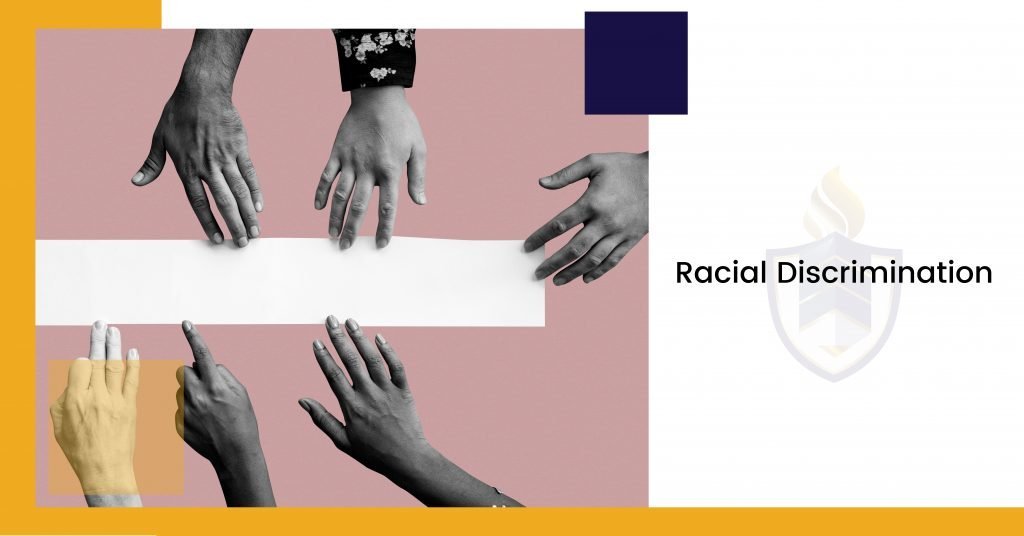Education for all boys and girls
Discrimination in education is the act of discriminating against people belonging to certain categories in enjoying full right to education. It is considered a violation of human rights. Education discrimination can be on the basis of ethnicity, nationality, age, gender, race, economic condition, disability and religion.
he EHRC explains that in the Equality Act, race can mean your colour, or your nationality (including your citizenship). It can also mean your ethnic or national origins, which may not be the same as your current nationality. For example, you may have Chinese national origins and be living in Britain with a British passport.
Race also covers ethnic and racial groups. This means a group of people who all share the same protected characteristic of ethnicity or race.
A racial group can be made up of two or more distinct racial groups, for example black Britons, British Asians, British Sikhs, British Jews, Romany Gypsies and Irish Travellers .
You may be discriminated against because of one or more aspects of your race, for example people born in Britain to Jamaican parents could be discriminated against because they are British citizens, or because of their Jamaican national origins.
In many parts of the world, such racial, ethnic, and religious discriminatory practices are still widespread. They take on many forms, at times dramatically brutal and at others sly and underhand. It is detrimental to group and individual identity and to living together peacefully. Its aim is to highlight the disparities between girls’ and boys’ experiences of school and encourage the international community and national governments to achieve gender equality in schools and bring about an end to gender discrimination.
Gender equality is not only a fundamental human right, but a necessary foundation for a peaceful, prosperous and sustainable future. Eradicating gender issues means a world where women and men, girls and boys all enjoy equal rights, resources, opportunities and protections.
Empowering girls from the start is proven to have lasting and compounding benefits over the course of their lives. When girls are supported to be active in civic and political spaces, in particular, they are empowered with the tools and skills they need to be drivers of positive change in their families and communities. Girls are the experts of their own experiences, priorities and needs, and are powerful catalysts for a a world where gender equality flourishes.
There are four main types of racial discrimination:
It can be direct or indirect, it may also take the form of harassment or victimisation.
We outline these different types below:
Direct race discrimination:
It is direct race discrimination to treat someone less favourably than someone else would be treated in the same circumstances, because of race. To prove direct race discrimination, it will help if you can give an example of someone from a different racial group who, in similar circumstances, has been, or would have been, treated more favourably than you. Racist abuse and harassment are forms of direct discrimination.
One example of direct race discrimination is where you are from a particular racial group and an employer refuses to appoint you because, the employer says, you ‘wouldn’t fit in’. It’s also direct discrimination if an employer turns you down for a job because of your connection with someone else of a particular racial group. For example, an employer might turn you down for a job because your partner is Afro-Caribbean.
Indirect race discrimination:
It is indirect race discrimination to have a rule or policy which people of a particular racial, ethnic or national group are less likely to be able to meet than other people, and this places them at a disadvantage.
Examples of indirect discrimination might include: an employer insisting that candidates for a job should have UK qualifications the banning of wearing headscarves, or insisting on the wearing of skirts, at work or at school
We have written another article on the topic of adhering to dress codes in schools. If you think that indirect race discrimination might have occurred, you may be able to make a complaint about it. However, if the person or organisation you are complaining about can show that there are genuine reasons for the rule, policy or practice and that it has nothing to do with race, this won’t count as discrimination.
For example, an employer may be able to show why an employee needs to have gained their qualifications in the UK in order to work in a particular role. If they can do this, there won’t have been any discrimination.
Harassment:
Harassment occurs when someone makes you feel humiliated, offended or degraded. For example: a young British Asian man at school keeps being called a racist name by colleagues. His colleagues say it is just banter, but the employee is insulted and offended by it
Harassment can never be justified. However, if an organisation or employer can show it did everything it could to prevent people who work for it from behaving like that, you will not be able to make a claim for harassment against it, although you could make a claim against the harasser.
Victimisation:
This is when you are treated badly because you have made a complaint of race related discrimination under the Equality Act. It can also occur if you are supporting someone who has made a complaint of race related discrimination. For example:
the young man in the example above wants to make a formal complaint about his treatment. His manager threatens to sack him unless he drops the complaint
Employers should ensure they have policies in place which are designed to prevent race discrimination in:
recruitment
determining pay, and terms and conditions of employment
training and development
selection for promotion
discipline and grievances
countering bullying and harassment
when an employee is dismissed
Steps to be taken in order to prevent it from happening:
- Schools should be safe havens, free from racism and discrimination.
- Governments, civil society and schools should work together to:
- mandate schools to incorporate the fight against racism and discrimination, as well as respect for diversity, into how they are run;
- ensure that human rights education is offered from nursery school onwards and that teaching materials are free from racist content and updated to reflect the diversity and plurality of society;
- provide incentives for responsible use of the Internet;
- ensure that schools adopt and enforce a code of conduct against racism and discrimination for pupils and staff;
- monitor racist incidents in schools and pursue policies to end them
- Policymakers, teachers and families must all work together to promote equality and non-discrimination:
- policymakers must create, enforce and fund policies to eliminate discrimination;
- teachers must be trained to work with children from all backgrounds;
- pupils’ parents should be included in their school’s decisions to promote equality and non-discrimination in education.
- Children from all backgrounds must have equal access to education and be fully integrated into the school system.
- Governments, civil society and schools should work together to:
- monitor key statistics on minority children such as school attendance, drop-out rates and academic performance;
- tackle any segregation of minority children in schools by preventing them from being placed into separate classes and helping minority children learn the language of instruction;
- encourage recruitment of teachers from minority groups;
- actively promote equality through awareness-raising campaigns targeted at all pupils and their families.
- Teachers must be trained for working with all children and be sensitive to the needs of pupils from different backgrounds, including on issues relating to human rights and racial discrimination.
- Governments, civil society and schools should work together to:
- ensure that teachers are trained to prevent any manifestations of racism and racial discrimination at school, and to react promptly and effectively when faced with such problems.
- Governments must provide the appropriate financial resources for schools to be able to promote equality and non-discrimination and regularly monitor the situation.

Dr. Mamta Singh
B.A | B.Ed | M.A | Persuing M.Ed
School Principal at Rahul Education, Queen Mary’s High School
FAQS
Racial discrimination is an extension of racist thoughts or feelings. It is discrimination (i.e. a behaviour or practice) based on a person’s skin colour, cultural heritage or nationality which stops the victim from participating fully in public life.
Racism is a combination of attitudes, beliefs and behaviours, such as believing your race is superior to another race, offensive or aggressive behaviour towards someone due to their race, language, or culture.
A comment is racist if person is offended by a comment about or relating to their skin colour, nationality or cultural background regardless of whether or not the comment was intended to be hurtful or offensive.
- Direct discrimination: This happens when someone treats you worse than another person in a similar situation because of your race.
- Indirect discrimination: This happens when an organisation has a particular policy or way of working that puts people of your racial group at a disadvantage.
- Harassment: Harassment occurs when someone makes you feel humiliated, offended or degraded.
- Victimisation: This is when you are treated badly because you have made a complaint of race related discrimination under the Equality Act. It can also occur if you are supporting someone who has made a complaint of race related discrimination.
Racism can happen just about anywhere. Research indicates that racism happens most frequently in the neighbourhood, shops, and in the workplace. It also happens on public transport, at sporting events or at schools. Racism is sometimes expressed in the media.
- Develop a Comprehensive Antidiscrimination Policy.
- Distribute the Policy to All Employees.
- Establish a User-Friendly Complaint Procedure.
- Investigate All Complaints Thoroughly.
- Protect Complainants from Retaliation.
- Take Appropriate Action.
Discrimination affects people’s opportunities, their well-being, and their sense of agency. Persistent exposure to discrimination can lead individuals to internalize the prejudice or stigma that is directed against them, manifesting in shame, low self-esteem, fear and stress, as well as poor health.
- Asking Inappropriate Personal Questions. You expect potential employers to ask questions about you to get to know you better during the interview process.
- Lack of Diversity.
- Gendered Roles and Duties.
- Offensive Comments, Jokes, and Other Forms of Communication.
Education discrimination can be on the basis of ethnicity, nationality, age, gender, race, economic condition, disability and religion.
Prevent and challenge discrimination-
Help all children to feel good about their race, ethnicity, culture and faith. stereotypes which can undermine their wellbeing and sense of self. foundation stage upwards, schools can include work about acceptance and about avoiding stereotypes and prejudice.
Ensure staff and pupils understand what behaviour is expected of them. Acknowledge that discrimination exists in wider society, and that it can lead to discriminatory bullying in schools. Be clear that reports of this behaviour will be taken extremely seriously and that such behaviour won’t be tolerated.
Schools can tackle discrimination by promoting democracy, respect for human rights and citizenship. To ensure that all students’ needs are met equally, schools need to prioritise language and cultural competences, in history and gender equality.


